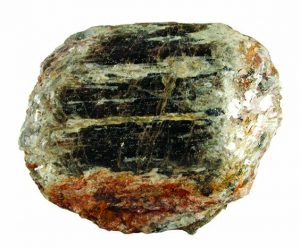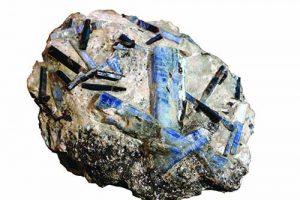
What are index minerals? These minerals are found in rocks and are used to help geologists understand how that rock was formed. The top three index minerals are kyanite, andalusite, and sillimanite.
When you admire a nicely cut specimen of charoite, surely you wonder how and where it formed. It may come as a surprise to learn the rock consists of more than a dozen minerals. Additionally, the formation of this rock takes place deep within (as far as nine miles down) the earth’s crust.
Geologists do not have x-ray vision, nor have they been that deep into the earth, so how do they know what happens that deep in the earth’s crust? After all, the charoite rock and all others must be close to the surface so we can study them. What brought them to us is the crustal movement. There must be clues in deeply formed rocks that give away hidden secrets, telling us how far down into the earth something forms. The clues do exist and are present within minerals in such rocks. They are known as index minerals.
Products of Serious Heat and Pressure

Index minerals are not minerals listed alphabetically in a book. They are minerals Mother Nature forms deep in the earth, using incredible amounts of pressure and temperature so high it is hard to believe the numbers. I’ve been underground in mines where the rock temperature is nearly 150 degrees. The deep gold mines in South Africa are far hotter, but such temperatures are child’s play compared to deep crust temperatures and pressures.
For some index minerals to even form, the temperatures have to be hundreds of times higher than the boiling point of water. The pressure down deep has to be thousands of pounds per square inch, which is much greater than on earth’s surface, where atmospheric pressure is about 14.7 pounds per square inch at sea level. The pressure deep in the crust is so significant we don’t measure it in pounds per inch. We use millibars. One hundred millibars equal 14.7 pounds per square inch. Deep in the crust, the pressure is measured in thousands of millibars, so we write it as kilobars.
During metamorphic action, the pressure on rock can reach 50 thousand pounds per square inch. We know diamonds form deep in the earth where the earth’s lower crust and its upper mantle meet. In the lab, we make diamonds at 3,000 degrees Celsius and pressure that measures 50,000 pounds per square inch.
Such high temperatures are far greater than what is needed to melt rock. Molten lava runs around 2,000 degrees Fahrenheit. So why isn’t the earth’s interior primarily liquid? The pressure is the answer. The rock is under such high pressure it can’t expand to liquefy, so it is in a plastic-like state. With the rock in that state, mineral molecules move slowly toward each other. Given eons of time, this builds larger molecules, which can develop into discrete mineral crystal species that form under such high heat and pressure.
The result of all this is a suite of minerals geologists call index minerals because they only form within certain high temperatures and pressures when they crystallize. The mineral species present, in turn, tells us how high these temperatures and pressures were when these minerals formed. Later the rock is moved toward the upper crust through mountain building or continental movement and is exposed by weathering or mining and then found by rockhounds. It is the index mineral species that form at a depth that tell us charoite and other minerals, as well as the pegmatite formations, were once present. Such deep forming minerals help us understand the circumstances of where the formation of metamorphic rock occurs.
Before we could accurately estimate the conditions around metamorphic rock development using index minerals, we used other means to tell us what goes on beneath our feet. One primary source we still use is earthquakes, both natural and human-made. When there is a major earthquake, the earth vibrates, sending out waves of motion, and the entire earth shakes. As these waves encounter rocks of differing compositions and densities, the waves slow down, speed up, or turn, and we map them. By tracking and measuring waves, we have a pretty good picture of the earth’s interior and even its rock types. By creating our earthquakes with explosions or heavy surface pounding, we can generate the same waves, which helps us study the crust. But these actions do nothing to identify temperatures and pressures. Index minerals provide information that allows scientists to estimate temperatures and pressures as rocks go through metamorphism.
Metamorphism In Action
There are two general types of metamorphism, regional and contact. The latter is what we might say is localized since it occurs in existing rock formations like limestone when invaded by a hot igneous formation. The pressure and heat of this intrusion have a dramatic effect on the rock. Hot solutions, coupled with re-crystallization of the invaded rock, can create an entirely new suite of minerals. For instance, when heat and pressure impact limestone, it re-crystallizes as marble, and a different suite of mineral species may develop.
Regional metamorphism is much more insidious and extensive. It develops over vast areas of rock because of continental collisions, mountain building, or other major geologic events on a broad scale. This action and resulting mineral development are exceedingly slow and long-lasting, almost never-ending. Within such activity, many different mineral species develop, many of them not particularly attractive or colorful. They remain locked in the host rock and rarely appear free-standing.
You may ask how discrete crystals can develop when they are locked in solid rock. During extreme metamorphic action, the rock is not stable, but in a plastic-like state in which fluid-like mineral molecules can slowly move, accumulate, and develop crystals. Regional metamorphism can continue for millions of years and is still happening as continents drift, giving mountain-building minerals plenty of time to form. The slow and inexorable pressure and heat produce a group of minerals called aluminosilicates.
These are minerals whose composition is aluminum, silicon, and oxygen, usually with metal element impurities.
Among the aluminosilicates are three polymorphous examples that form in metamorphic rock and are categorized as index minerals; these are sillimanite, kyanite, and andalusite. Polymorphs have the same chemical composition but form in different crystal systems or different internal crystal structures. The two index minerals andalusite and sillimanite form in the orthorhombic system but differ internally. They also tend to form at the higher end of the temperature and pressure ranges during metamorphic action. The index mineral kyanite can develop in an even more extensive range of temperatures and pressures than the other two, so it may be present in both contact and regional metamorphic rocks. By studying these three minerals in a substantial rock formation, geologists can determine three things about the composition: The depth where it formed, the temperature during development, and the amount of pressure present.
Understanding Sillimanite’s Rarity

embedded in schist matrix on this specimen from an
uncommon South Carolina locality. DR. ROB LAVINSKY, THE
ARKENSTONE GALLERY OF FINE MINERALS, WWW.IROCKS.COM
The three polymorphous minerals we’re examining each form in various temperature ranges. Andalusite forms in 200 to 800 degrees Celcius, but only if the pressure is low. Kyanite forms in the broadest range of these two factors and thus forms quite often. Sillimanite, on the other hand, forms under the most pressure, but only if the temperature is above 800 degrees Celsius.
Sillimanite is not a particularly attractive mineral. It is usually fibrous and gray-brown, sometimes with a pink tint. The mineral was first identified in Chester, Connecticut, and named after Yale Professor Benjamin Silliman, who played an essential role in the emergence of the science of mineralogy. Sillimanite is rare, and you’ll probably never see any crystals for sale, except an occasional example mined in India. However, it is mind in various locations, specifically for industrial uses. My old 1948 Plymouth used spark plugs probably made using sillimanite because it is a superb refractory, a substance that can withstand high heat. Furnaces, kilns, and other high-temperature equipment are lined with bricks or tiles often made with sillimanite.
Interestingly, when the legislators of the great state of Delaware were looking to designate a state mineral, they chose sillimanite.
Andalusite’s Uncommon Formation

Andalusite does develop crystals, which tend to be a little odd because, in cross-section, they are perfectly square. The crystals grow in metamorphic schist, most commonly formed as sedimentary shale. Again, andalusite can resist high heat, so it is part of the production of refractory tiles, bricks, and ceramic materials. It will actually convert to sillimanite if the temperatures are raised high enough.
The first andalusite crystals reportedly appeared in Andalusia, Spain, in 1789. Industrial quantities of andalusite are allegedly typical in South Africa as well. The most unusual occurrence of andalusite occurs in mica schist, where the square crystals twin and form a cross. Repeated andalusite twinned crosses in mica schist is used as a decorative stone or cut in a cabochon gem shape. In the twinned form, this mineral has a different name, which is chiastolite.
Kyanite’s Market Prevalence

and staurolite from Switzerland. GROBEN COLLECTION
Of the three index minerals discussed, the one seen most often at shows and in displays is kyanite. It is difficult to imagine, but of the three index minerals listed here, kyanite forms deepest in the earth, where pressures can read over four kilobars. Yet, it is the only one of these three minerals that form in pegmatite deposits, in beautiful discrete prismatic crystals, with lively deep-to-light-blue coloration, due to minor metallic impurities.
In rare instances, kyanite can even appear green, due to iron, and orange when levels of manganese are present. Although green and orange examples are often cut into gems, it’s a challenge to accomplish, since kyanite is anisotropic.
Anisotropy is the property in any mineral presenting with two different levels of hardness in the same crystal. If you scratch a kyanite crystal across the long crystal axis, the hardness is 7, which is close to quartz. Scratch it the length of the long crystal axis, and the hardness is 5 to 5.5. Other minerals show anisotropy, but not to the same extreme as kyanite. Kyanite appears in long slender blade crystals, which are usually several inches long, and a fraction of an inch wide. Specimens are common in Switzerland, with the finest examples hailing from Brazil.
Kyanite also often accompanies crystals of staurolite, which is a popular iron, magnesium, and aluminum silicate, a metamorphic mineral that frequently forms in cross or X shaped twins.
Of the three index minerals, only Kyanite is truly attractive and colorful, and should undoubtedly appear in your collection. In reality, all three should, because as major index minerals, they make for good conversation when you talk about the role played by index minerals.
This story about agate formations previously appeared in Rock & Gem magazine. Click here to subscribe. Story by Bob Jones.















